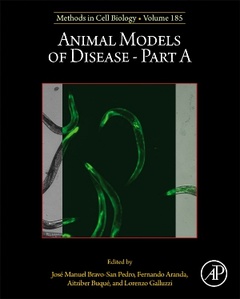Description
Animal Models of Disease Part A
Methods in Cell Biology Series
Language: English
Subject for Animal Models of Disease Part A:
Publication date: 04-2024
· 15x22.8 cm · Hardback
· 15x22.8 cm · Hardback
Description
/li>Contents
/li>Comment
/li>
Animal Models of Disease, Part A, Volume 185 in the Methods in Cell Biology series, highlights advances in the field, with this new volume presenting interesting chapters on a variety of timely topics, including New mouse model to study aneurysm development, Mouse Model of Secondary Cystic Echinococcosis, Modelling childhood cancer in Drosophila, Analysis of immunohistomorphological changes in the colonic mucosa in a high-saturated fat and high-cholesterol fed streptozotocin/nicotinamide diabetic rat model, Establishment of an orthotopic Glioblastoma mouse model for preclinical studies, Lateral Fluid Percussion Injury as a Model for Traumatic Brain Injury, Ovarian and colorectal peritoneal carcinomatosis in mouse models, and more.
Other chapters cover Genetically engineered mouse model of hepatocellular carcinoma, Radiotherapy protocol in cancer mouse models, Using C. elegans as a model for neurodegenerative diseases: Methodology and evaluation, Methodology for the induction of myocardial infarction and cardiac function evaluation, Behavioral assessment of fine socio-sexual olfactory cues detection in a mouse model of neurodegeneration, Heat shock and thermotolerance in Caenorhabditis elegans: an overview of laboratory techniques, and Using the model cestode Taenia crassiceps for the study of cysticercosis.
Other chapters cover Genetically engineered mouse model of hepatocellular carcinoma, Radiotherapy protocol in cancer mouse models, Using C. elegans as a model for neurodegenerative diseases: Methodology and evaluation, Methodology for the induction of myocardial infarction and cardiac function evaluation, Behavioral assessment of fine socio-sexual olfactory cues detection in a mouse model of neurodegeneration, Heat shock and thermotolerance in Caenorhabditis elegans: an overview of laboratory techniques, and Using the model cestode Taenia crassiceps for the study of cysticercosis.
Preface
Lorenzo Galluzzi, Fernando Aranda Vega, Aitziber Buque and José Manuel Bravo-San Pedro
1. Heat shock and thermotolerance in Caenorhabditis elegans: an overview of laboratory techniques
Nektarios Tavernarakis
2. Using the model cestode Taenia crassiceps for the study of cysticercosis
Marcela Alejandra Cucher
3. Modelling childhood cancer in Drosophila
Isabel Adrados
4. Establishment of an orthotopic Glioblastoma mouse model for preclinical studies
Nerea Iturrioz Rodriguez
5. Ovarian and colorectal peritoneal carcinomatosis in mouse models
Ángela Bella Carreño
6. Genetically engineered mouse model of hepatocellular carcinoma
Navarro Flor
7. Radiotherapy protocol in cancer mouse models
Maria Esperanza Rodriguez Ruiz
8. MURINE MODEL OF SECONDARY CYSTIC ECHINOCOCCOSIS
Gustavo Mourglia-Ettlin
9. Behavioral assessment of fine socio-sexual olfactory cues detection in a mouse model of neurodegeneration
Adrián Portalés and Alberto Sanchez Aguilera
10. Methodology for the induction of myocardial infarction and cardiac function evaluation
Ernesto Martinez Martinez
11. Analysis of immunohistomorphological changes in the colonic mucosa in a high-saturated fat and high-cholesterol fed streptozotocin/nicotinamide diabetic rat model.
Marina Hernandez Martin and F.J. Sanchez-Muniz
12. Lateral Fluid Percussion Injury as a Model for Traumatic Brain Injury
María Sancho and Luisa Lilia Rocha
Lorenzo Galluzzi, Fernando Aranda Vega, Aitziber Buque and José Manuel Bravo-San Pedro
1. Heat shock and thermotolerance in Caenorhabditis elegans: an overview of laboratory techniques
Nektarios Tavernarakis
2. Using the model cestode Taenia crassiceps for the study of cysticercosis
Marcela Alejandra Cucher
3. Modelling childhood cancer in Drosophila
Isabel Adrados
4. Establishment of an orthotopic Glioblastoma mouse model for preclinical studies
Nerea Iturrioz Rodriguez
5. Ovarian and colorectal peritoneal carcinomatosis in mouse models
Ángela Bella Carreño
6. Genetically engineered mouse model of hepatocellular carcinoma
Navarro Flor
7. Radiotherapy protocol in cancer mouse models
Maria Esperanza Rodriguez Ruiz
8. MURINE MODEL OF SECONDARY CYSTIC ECHINOCOCCOSIS
Gustavo Mourglia-Ettlin
9. Behavioral assessment of fine socio-sexual olfactory cues detection in a mouse model of neurodegeneration
Adrián Portalés and Alberto Sanchez Aguilera
10. Methodology for the induction of myocardial infarction and cardiac function evaluation
Ernesto Martinez Martinez
11. Analysis of immunohistomorphological changes in the colonic mucosa in a high-saturated fat and high-cholesterol fed streptozotocin/nicotinamide diabetic rat model.
Marina Hernandez Martin and F.J. Sanchez-Muniz
12. Lateral Fluid Percussion Injury as a Model for Traumatic Brain Injury
María Sancho and Luisa Lilia Rocha
- Provides the latest information on cancer research
- Offers outstanding and original reviews on a range of cancer research topics
- Serves as an indispensable reference for researchers and students alike
© 2024 LAVOISIER S.A.S.
These books may interest you

Biomolecular Interactions Part A 170.55 €



